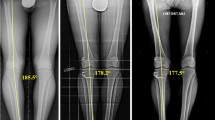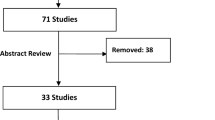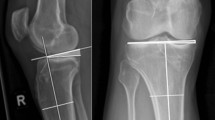Abstract
Purpose of Review
Anterior closing wedge osteotomies (ACWO) are utilized to better restore knee stability and in situ forces on anterior cruciate ligament (ACL) grafts during ACL revision reconstruction while reducing the risk of retearing and subsequent revision procedures. However, clinical outcomes following ACWO for patients undergoing ACL reconstruction remains largely limited. The purpose of this review was to provide a concise overview of the current literature on indication, techniques, and outcomes following ACWO in ACL-deficient patients undergoing primary or revision ACL reconstruction while discussing the authors’ preferred technique to ACWO during a staged ACL revision reconstruction.
Recent Findings
Currently available clinical studies and case reports have demonstrated ACWO to improve knee stability and outcomes for patients with an increased posterior tibial slope undergoing primary or revision ACL reconstruction with low complication rates.
Summary
The ACWO provides an adjunct surgical option to decrease graft failure while improving knee stability and post-surgical outcomes for patients with an increased posterior tibial slope undergoing primary or revision ACL reconstruction. Further investigations are warranted to validate currently reported outcomes following ACWO in higher-level clinical studies with longer-term follow-up.







Similar content being viewed by others
Change history
04 April 2022
A Correction to this paper has been published: https://doi.org/10.1007/s12178-022-09750-x
References
Papers of particular interest, published recently, have been highlighted as: • Of importance •• Of major importance
Borchers JR, Kaeding CC, Pedroza AD, Huston LJ, Spindler KP, Wright RW, on behalf of the MOON Consortium and the MARS Group, Albright JP, Allen CR, Amendola A, Anderson AF, Andrish JT, Annunziata CC, Arciero RA, Bach BR Jr, Baker CL 3rd, Bartolozzi AR, Baumgarten KM, Bechler JR, et al. Intra-articular findings in primary and revision anterior cruciate ligament reconstruction surgery: a comparison of the MOON and MARS study groups. Am J Sports Med. 2011;39:1889–93.
Gianotti SM, Marshall SW, Hume PA, Bunt L. Incidence of anterior cruciate ligament injury and other knee ligament injuries: a national population-based study. J Sci Med Sport. 2009;12:622–7.
Mehl J, Otto A, Baldino JB, Achtnich A, Akoto R, Imhoff AB, Scheffler S, Petersen W. The ACL-deficient knee and the prevalence of meniscus and cartilage lesions: a systematic review and meta-analysis (CRD42017076897). Arch Orthop Trauma Surg. 2019;139:819–41.
Cantivalli A, Rosso F, Bonasia DE, Rossi R. High tibial osteotomy and anterior cruciate ligament reconstruction/revision. Clin Sports Med. 2019;38:417–33.
Gans I, Retzky JS, Jones LC, Tanaka MJ. Epidemiology of recurrent anterior cruciate ligament injuries in national collegiate athletic association sports: the injury surveillance program, 2004-2014. Orthop J Sports Med. 2018;6:2325967118777823.
• Sonnery-Cottet B, Mogos S, Thaunat M, Archbold P, Fayard J-M, Freychet B, et al. Proximal tibial anterior closing wedge osteotomy in repeat revision of anterior cruciate ligament reconstruction. Am J Sports Med. 2014;42:1873–80. Clinical series suggesting ACWO restores knee stability and function with good clinical outcomes in patients with recurrent ACL ruptures and associated increased PTS
Rahardja R, Zhu M, Love H, Clatworthy MG, Monk AP, Young SW. Rates of revision and surgeon-reported graft rupture following ACL reconstruction: early results from the New Zealand ACL Registry. Knee Surg Sports Traumatol Arthrosc: Off J ESSKA. 2020;28:2194–202.
Kamath GV, Redfern JC, Greis PE, Burks RT. Revision anterior cruciate ligament reconstruction. Am J Sports Med. 2011;39:199–217.
Todd MS, Lalliss S, Garcia E, DeBerardino TM, Cameron KL. The relationship between posterior tibial slope and anterior cruciate ligament injuries. Am J Sports Med. 2010;38:63–7.
•• Ni Q-K, Song G-Y, Zhang Z-J, Zheng T, Feng Z, Cao Y-W, et al. Steep Posterior Tibial slope and excessive anterior tibial translation are predictive risk factors of primary anterior cruciate ligament reconstruction failure: a case-control study with prospectively collected data. Am J Sports Med. 2020;48:2954–61. Case-control study indicating a high PTS and ATT are predictive risk factors of primary ACLR failure, highlighting the importance of PTS correction when appropriate
•• Nishino K, Hashimoto Y, Nishida Y, Nakamura H. Anterior cruciate ligament reconstruction with anterior closing wedge osteotomy for failed high tibial osteotomy–a case report. Int J Surg Case Rep. 2020;73:116–20. Case report of a patient with symptomatic knee instability secondary to an increased PTS above 15° successfully treated with an ACWO following a previously failed open wedge HTO with primary injury of the ACL, indicating an additional potential indication of this procedure
•• Hees T, Petersen W. Anterior closing-wedge osteotomy for posterior slope correction. Arthrosc Tech. 2018;7:e1079–87. Technical note describing key indications and surgical steps to perform a successful ACWO and correct an increased PTS
Won HH, Chang CB, Je MS, Chang MJ, Kim TK. Coronal limb alignment and indications for high tibial osteotomy in patients undergoing revision ACL reconstruction. Clin Orthop Relat Res. 2013;471:3504–11.
Amendola A, Bonasia DE. Results of high tibial osteotomy: review of the literature. Int Orthop. 2010;34:155–60.
Shelburne KB, Kim H-J, Sterett WI, Pandy MG. Effect of posterior tibial slope on knee biomechanics during functional activity. Journal of Orthopaedic Research: Off Publ Orthop Res Soc. 2011;29:223–31.
Agneskirchner JD, Hurschler C, Stukenborg-Colsman C, Imhoff AB, Lobenhoffer P. Effect of high tibial flexion osteotomy on cartilage pressure and joint kinematics: a biomechanical study in human cadaveric knees. Winner of the AGA-DonJoy Award 2004. Arch Orthop Trauma Surg. 2004;124:575–84.
•• DePhillipo NN, Kennedy MI, Dekker TJ, Aman ZS, Grantham WJ, LaPrade RF. Anterior closing wedge proximal tibial osteotomy for slope correction in failed ACL reconstructions. Arthroscopy Techniques. 2019;8:e451–7. Technical note describing key indications, surgical considerations, and rehabilitation of a patient with recurrent ACL ruptures and increased PTS
Queiros CM, Abreu FG, Moura JL, de Abreu GV, Vieira TD, Helfer L, Sonnery-Cottet B. Anterior closing-wedge osteotomy for posterior slope correction with tibial tubercle preservation. Arthroscopy Techniques. 2019;8:e1105–9.
Imhoff FB, Mehl J, Comer BJ, Obopilwe E, Cote MP, Feucht MJ, Wylie JD, Imhoff AB, Arciero RA, Beitzel K. Slope-reducing tibial osteotomy decreases ACL-graft forces and anterior tibial translation under axial load. Knee Surg Sports Traumatol Arthrosc: Off J ESSKA. 2019;27:3381–9.
•• Yamaguchi KT, Cheung EC, Markolf KL, Boguszewski DV, Mathew J, Lama CJ, et al. Effects of anterior closing wedge tibial osteotomy on anterior cruciate ligament force and knee kinematics. Am J Sports Med. 2018;46:370–7. Biomechanical analysis demonstrating PTS-reducing osteotomy successfully reduces the forces placed across the ACL and ATT of the knee across various loading conditions
• Dejour D, Saffarini M, Demey G, Baverel L. Tibial slope correction combined with second revision ACL produces good knee stability and prevents graft rupture. Knee Surg Sports Traumatol Arthrosc: Off J ESSKA. 2015;23:2846–52. Study constitutes the highest level of evidence regarding the outcomes of an ACWO. The authors indicate good knee stability and reduced risk of graft rupture following ACWO combined with revision ACL reconstruction
Walker J, Hartigan D, Stuart M, Krych A. Anterior closing wedge tibial osteotomy for failed anterior cruciate ligament reconstruction. The Journal of Knee Surgery Reports. Thieme Med Publishers. 2015;1:51–6.
Portner O. High tibial valgus osteotomy: closing, opening or combined? Patellar height as a determining factor. Clin Orthop Relat Res. 2014;472:3432–40.
Hashemi J, Chandrashekar N, Gill B, Beynnon BD, Slauterbeck JR, Schutt RC, et al. The geometry of the tibial plateau and its influence on the biomechanics of the tibiofemoral joint. J Bone Joint Surg Am. 2008;90:2724–34.
Hashemi J, Chandrashekar N, Mansouri H, Gill B, Slauterbeck JR, Schutt RC, et al. Shallow medial tibial plateau and steep medial and lateral tibial slopes: new risk factors for anterior cruciate ligament injuries. Am J Sports Med. 2010;38:54–62.
Bauer T, Hardy P, Lemoine J, Finlayson DF, Tranier S, Lortat-Jacob A. Drop foot after high tibial osteotomy: a prospective study of aetiological factors. Knee Surg Sports Traumatol Arthrosc: Off J ESSKA. 2005;13:23–33.
Engel GM, Lippert FG. Valgus tibial osteotomy: avoiding the pitfalls. Clin Orthop Relat Res. 1981;160:137–43.
Mattei L, Lea S, Nicolaci G, Ferrero G, Marmotti A, Castoldi F. Closing wedge tibial osteotomy: is it an actual procedure nowadays? Annals of Joint. 2017;2:30.
Bettin D, Karbowski A, Schwering L, Matthiaß HH. Time-dependent clinical and roentgenographical results of Coventry high tibial valgisation osteotomy. Arch Orthop Trauma Surg. 1998;117:53–7.
Ivarsson I, Myrnerts R, Gillquist J. High tibial osteotomy for medial osteoarthritis of the knee. A 5 to 7 and 11 year follow-up. The Journal of Bone and Joint Surgery British Volume. 1990;72:238–44.
Wu L-D, Hahne HJ, Hassenpflug T. A long-term follow-up study of high tibial osteotomy for medial compartment osteoarthrosis. Chin J Traumatol = Zhonghua Chuang Shang Za Zhi. 2004;7:348–53.
Author information
Authors and Affiliations
Corresponding author
Ethics declarations
Human and Animal Rights and Informed Consent
This article does not contain any studies with human or animal subjects performed by any of the authors.
Conflict of Interest
Amar Vadhera, Derrick Knapik, Safa Gursoy, Daniel Farivar, and Allison Perry declare that they have no conflict of interest.
Jorge Chahla is a paid consultant of Arthrex, Inc, CONMED Linvatec, Ossur, and Smith & Nephew, outside of the submitted work. He is a board or committee member of American Orthopaedic Society for Sports Medicine, Arthroscopy Association of North America, and International Society of Arthroscopy, Knee Surgery, and Orthopaedic Sports Medicine.
Brian Cole is Dr. Cole reports receiving research support or royalties, serves as a paid consultant, or other financial support from Aesculap, NIH, Operative Techniques in Sports Medicine, Ossio, Regentis, Smith and Nephew, Arthrex Inc, Elsevier publishing, Bandgrip Inc, Acumed LLC, Encore Medical, LP, GE Healthcare, Merck Sharp & Dohme Corporation, SportsTek Medical, Inc, and Vericel Corporation, outside of the submitted work.
Additional information
Publisher’s note
Springer Nature remains neutral with regard to jurisdictional claims in published maps and institutional affiliations.
This article is part of the Topical Collection on Outcomes Research in Orthopedics
The original online version of this article was revised: In this article the author name "Daniel Farivar" was incorrectly written as "Daniel Farviar".
Rights and permissions
About this article
Cite this article
Vadhera, A.S., Knapik, D.M., Gursoy, S. et al. Current Concepts in Anterior Tibial Closing Wedge Osteotomies for Anterior Cruciate Ligament Deficient Knees. Curr Rev Musculoskelet Med 14, 485–492 (2021). https://doi.org/10.1007/s12178-021-09729-0
Accepted:
Published:
Issue Date:
DOI: https://doi.org/10.1007/s12178-021-09729-0




